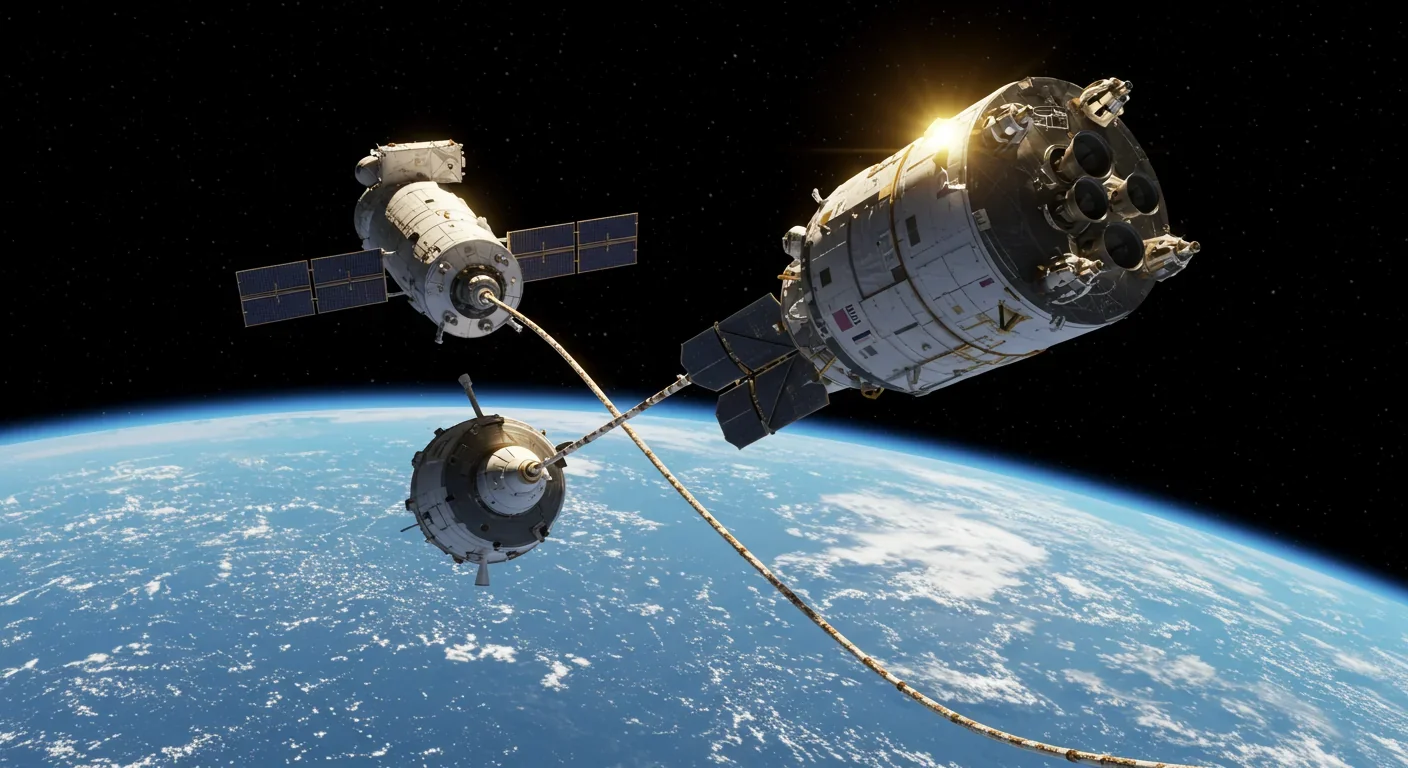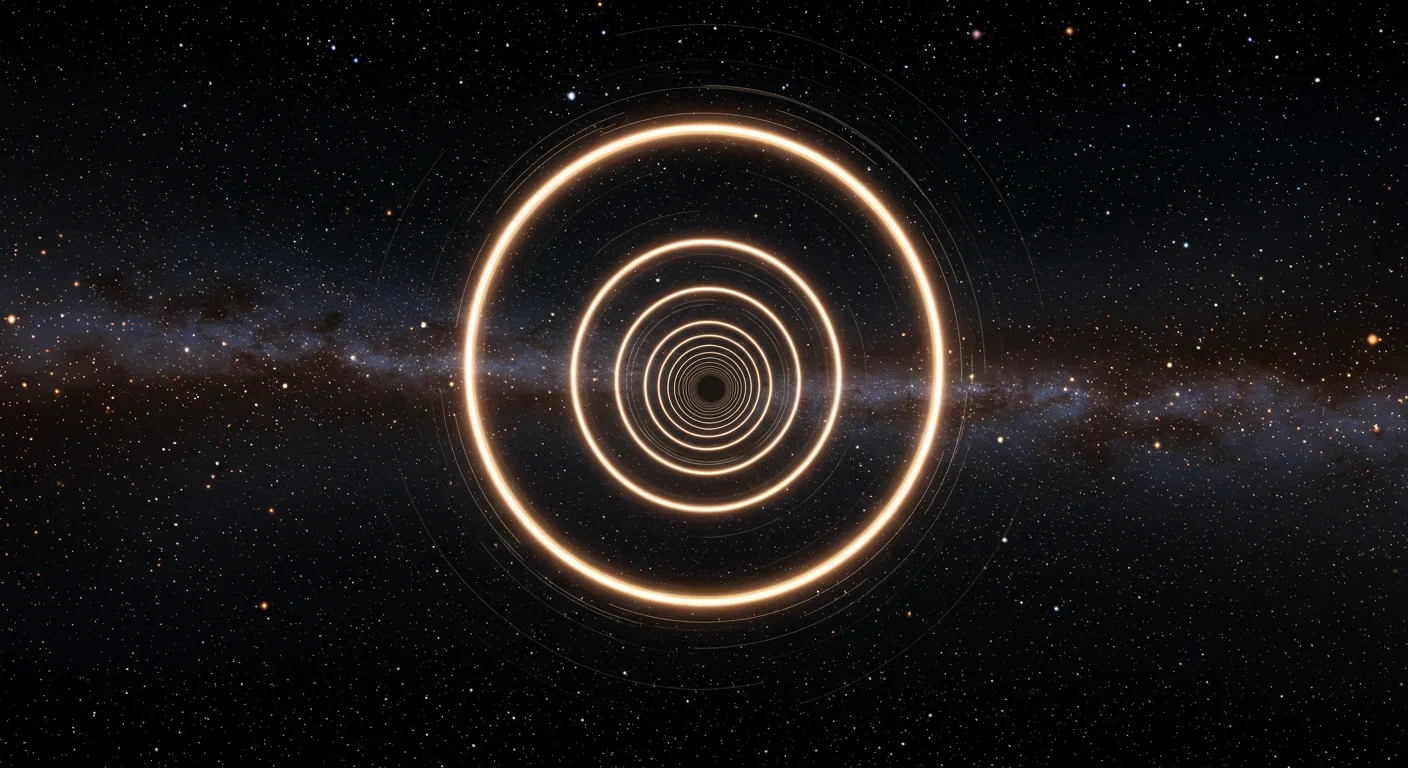Orbital Refueling Depots: Space's New Infrastructure

TL;DR: Wormholes collapse instantly because they require exotic matter with negative energy that doesn't exist in useful quantities, and quantum instabilities destroy them faster than light can cross their throats, making spacetime shortcuts a physics impossibility.

Back in 1935, Einstein and Nathan Rosen were tinkering with equations when they stumbled onto something strange. Their math suggested spacetime could fold back on itself, creating tunnels between distant points in the universe. These Einstein-Rosen bridges, as they're formally known, looked perfectly legitimate on paper. The equations worked. The geometry checked out. There was just one problem: they'd collapse faster than light could cross them.
That timing issue isn't some minor engineering challenge we'll solve with better technology. It's a fundamental showstopper written into the fabric of reality itself.
Think of spacetime as a rubber sheet. Normal matter creates dips in that sheet, which we experience as gravity. A wormhole would be different. It would require pushing the sheet outward, holding open a tunnel against the natural tendency of spacetime to snap shut. That pushing requires something physicists call exotic matter.
Exotic matter isn't just rare or hard to find. It would need negative energy density, meaning it would have to behave opposite to every form of matter and energy we've ever observed. While normal matter pulls spacetime inward, exotic matter would push it outward. The problem is that we've never found anything remotely capable of doing this at the scale required.
There's one glimmer of hope called the Casimir effect. When you place two conducting plates incredibly close together in a vacuum, quantum fluctuations create a tiny region of negative energy between them. Hendrik Casimir predicted this in 1948, and Steven Lamoreaux confirmed it experimentally in 1997. But here's the catch: the effect is minuscule, working only at atomic scales. Scaling it up to hold open a wormhole throat wide enough for a person, let alone a spaceship, would require violating quantum field theory itself.
The math says you can't just make negative energy arbitrarily large. Quantum field theory breaks down at those extremes. It's not a question of finding enough exotic matter, because the universe seems designed to prevent that much from existing in one place.
Even if you somehow manufactured enough exotic matter to prop open a wormhole, you'd face a second physics nightmare: quantum instability. Any particle trying to pass through the wormhole would interact with the geometry itself. Those interactions create feedback loops that amplify with each passing moment.
Imagine trying to keep a soap bubble perfectly stable while someone throws sand at it. Every grain hitting the surface creates ripples, and those ripples interfere with each other, creating bigger disturbances. Eventually, the bubble pops. Wormholes face the same problem, except the "sand" is quantum fluctuations inherent to spacetime itself, and they're unavoidable.
Stephen Hawking showed that black holes emit radiation through quantum effects at their event horizons. A wormhole throat would experience similar radiation, except the geometry would trap and amplify it. Hawking radiation bouncing back and forth inside the tunnel would build up exponentially, destabilizing the structure in fractions of a second. Before anything could traverse the shortcut, the wormhole would either collapse into a black hole or simply seal itself shut.
This isn't speculation. The calculations are clear: quantum field theory in curved spacetime predicts that traversable wormholes are unstable against their own quantum fluctuations.
General relativity allows wormholes mathematically, but physics imposes constraints called energy conditions. The most relevant one is the null energy condition, which states that the energy density measured by any observer moving at the speed of light must be non-negative. Normal matter obeys this rule. Exotic matter violates it.

Every experiment we've ever conducted confirms that the null energy condition holds in the real world. The only exception is the Casimir effect, and even that creates negative energy so small it's barely measurable. Quantum field theory allows temporary, localized violations, but they're bounded. You can't stack them up indefinitely.
Physicists have tried to find loopholes. Some proposals invoke extra dimensions or modified gravity theories. Others suggest using quantum entanglement to avoid needing exotic matter altogether. The ER=EPR conjecture, proposed by Leonard Susskind and Juan Maldacena in 2013, suggests that entangled particles might be connected by non-traversable wormholes. But even if that's true, it doesn't make those wormholes traversable. The connection exists in the math, not in any way you could use to travel.
So exactly how fast do wormholes collapse? The answer depends on their size, but it's always catastrophically quick. For a wormhole with a throat radius comparable to a human body, general relativity predicts collapse in something like 10^-43 seconds, the Planck time. That's the shortest meaningful interval in physics. Light could barely move a Planck length, about 10^-35 meters, in that time.
Even if you made the wormhole larger, you'd only buy yourself marginally more time. A wormhole with a throat the size of Earth might last a few microseconds before quantum instabilities tore it apart. That's still faster than light could cross from one end to the other.
The fundamental issue is that general relativity treats spacetime as a smooth continuum, while quantum mechanics says it's inherently grainy at small scales. When you try to create extreme curvature, like a wormhole throat, those two descriptions clash. Quantum gravity, which nobody has figured out yet, would be needed to resolve the contradiction. Until then, the collapse timeline remains firmly in the "instant" category.
Movies like Interstellar showed wormholes that humans could traverse. The film's scientific advisor, physicist Kip Thorne, designed a mathematically consistent wormhole for the story. But even Thorne acknowledged the exotic matter problem. In the film's universe, some advanced civilization presumably solved the problem by gathering or creating exotic matter in quantities far beyond anything physics allows.
That's the key word: fiction. Science fiction uses wormholes as narrative devices because they're conceptually elegant and visually interesting. But every realistic treatment acknowledges they require technology or physics we don't have and may never have.
Some stories handwave the problem by invoking mysterious "negative mass" or "antigravity." But negative mass creates its own contradictions. If you pushed on negative mass, it would accelerate toward you instead of away. That violates energy conservation in ways that would unravel causality itself. Physicists have explored these ideas, but they always lead to paradoxes that suggest nature forbids such things.
Over the past decade, physicists have published dozens of papers exploring potential workarounds. Some researchers investigate whether dark matter halos could stabilize wormholes without exotic matter. Others examine modified gravity theories like f(R,T) gravity to see if changing the rules might help. A few have even proposed using quantum entanglement as a substitute for exotic matter.
None of these approaches have succeeded. Dark matter, while mysterious, still has positive energy density. It can't prop open a wormhole any better than normal matter. Modified gravity theories either fail to produce traversable wormholes or require conditions even more extreme than exotic matter. Quantum entanglement creates mathematical connections but not physical tunnels you could fly through.
In 2024, researchers published work on Kaluza-Klein wormholes, which invoke extra dimensions. But even those require exotic matter in the four-dimensional spacetime we inhabit. The extra dimensions don't eliminate the energy condition violations; they just relocate them.
Perhaps most telling, nobody has found a way to create even a microscopic, laboratory-scale wormhole. If it were possible, you'd expect to see proposals for experiments involving particle accelerators or quantum systems. Instead, the research remains purely theoretical, focused on finding mathematical solutions rather than practical implementations.
The ultimate answer may come from quantum gravity, the long-sought theory that would unite general relativity and quantum mechanics. String theory, loop quantum gravity, and other candidates all have something to say about wormholes, but their predictions vary.

Some string theory models suggest that wormholes could exist as quantum foam fluctuations at the Planck scale, far too small to be useful. Loop quantum gravity predicts that spacetime itself becomes discrete at tiny scales, which might prevent wormhole throats from forming at all. Other approaches, like causal set theory, impose strict limits on how spacetime can be connected, potentially ruling out traversable wormholes entirely.
Recent work on quantum entanglement and wormholes has revealed intriguing connections, but nothing suggesting we could stabilize a macroscopic tunnel. If anything, the trend in quantum gravity research points away from traversable wormholes, not toward them.
The deeper we probe, the more constraints we find. Physics isn't saying wormholes are impossible because we lack imagination or technology. It's saying the universe has rules, and those rules don't permit stable spacetime shortcuts.
If wormholes are off the table, what does that mean for interstellar travel? It means we're stuck with the speed limit: light travels about 300,000 kilometers per second, and nothing with mass can match it. The nearest star system, Alpha Centauri, is 4.37 light-years away. Even traveling at 10% of light speed, an extraordinary achievement, the trip would take 43 years.
Some researchers are exploring alternatives like warp drives, which would compress spacetime in front of a ship and expand it behind. Miguel Alcubierre proposed this in 1994, and it's mathematically consistent with general relativity. But it also requires exotic matter, just like wormholes. The energy requirements are equally absurd, potentially requiring the mass-energy of an entire galaxy.
Generation ships, where multiple human lifetimes pass during the journey, remain the most plausible option for interstellar travel with current physics. That's not inspiring, but it's honest. We might improve propulsion to shorten the trip, or develop better hibernation techniques, but we're not going to cheat the distance.
Some physicists hold out hope that future discoveries will reveal loopholes in our current understanding. Maybe there's a form of energy we haven't detected yet that could stabilize a wormhole. Maybe quantum gravity will permit structures we can't currently imagine. But betting on unknown physics is just hopeful speculation.
What's fascinating is that wormholes almost work. Einstein's equations permit them. The geometry is elegant. The concept is simple: fold spacetime and punch a hole through. It's only when you add quantum mechanics and energy conditions that everything falls apart.
That near-miss tells us something important about the universe. General relativity is incredibly permissive. It allows black holes, time dilation, gravitational waves, all manner of exotic phenomena. But quantum mechanics and thermodynamics impose limits that prevent the most extreme possibilities. Nature allows just enough strangeness to be interesting without permitting logical contradictions.
Wormholes sit right at that boundary. They're theoretically possible in the same way a perpetual motion machine is mechanically possible if you ignore friction and thermodynamics. Once you include all the physics, the permission evaporates.
Mathematicians still study wormhole solutions because they reveal properties of spacetime we might not otherwise understand. Physicists explore them to test the limits of general relativity. But nobody seriously expects to build one.
Despite the physics, wormholes remain culturally powerful. They represent human desire to transcend limitations. We want shortcuts. We want to explore distant galaxies within a single lifetime. We want the universe to be accessible, not locked behind insurmountable distances.
Science fiction keeps wormholes alive because they serve a narrative purpose. They let stories explore themes of connection, discovery, and the unknown without getting bogged down in realistic transit times. That's valuable. Stories don't need to be physically accurate to be meaningful.
But there's a danger in blurring the line between fiction and possibility. When people assume wormholes are just an engineering challenge rather than a physics impossibility, they misunderstand the nature of scientific limits. Some constraints are technological. We can't build fusion reactors yet, but nothing in physics forbids them. Wormholes are different. They're forbidden by the same laws that prevent you from traveling backward in time to kill your grandfather.
Understanding this distinction matters. It shapes how we think about the future, what investments we make in space exploration, and how we educate the next generation of scientists. False hope is worse than realistic limitation because it wastes resources and distorts priorities.
If wormholes are impossible, what can we do? Plenty. We can map nearby star systems with better telescopes. We can send robotic probes to explore them at a fraction of light speed. We can develop technologies that make long-duration space travel sustainable for humans. We can search for biosignatures on exoplanets, looking for evidence of life without needing to visit in person.
We might even discover new physics that changes our understanding of spacetime. But that discovery, if it comes, will emerge from evidence and experimentation, not wishful thinking about wormholes. Science advances by testing ideas, discarding those that fail, and building on those that succeed.
The wormhole stability problem has been tested extensively through theory and simulation. It fails every test. That's not a limitation of human ingenuity. It's a feature of physical law.
Accepting that wormholes are impossible doesn't diminish the universe. It just means the cosmos is vast in a way we have to respect. Distances are real. Time is real. The laws of physics constrain what's possible, and that's okay.
In fact, those constraints make the universe more interesting, not less. If you could instantly travel anywhere, exploration would lose meaning. The challenge of reaching distant places, of solving hard problems with limited tools, is what makes achievement valuable.
Wormholes will continue to appear in stories, and that's fine. They're useful metaphors for connection and discovery. But in reality, we're bound by the same physics that governs everything else. Exotic matter doesn't exist in useful quantities. Quantum instabilities destroy wormholes before they form. Energy conditions can't be violated at macroscopic scales.
These aren't obstacles to overcome. They're descriptions of how spacetime works. And understanding that distinction is the first step toward appreciating what the universe actually offers, rather than mourning what it doesn't.

Wormholes collapse instantly because they require exotic matter with negative energy that doesn't exist in useful quantities, and quantum instabilities destroy them faster than light can cross their throats, making spacetime shortcuts a physics impossibility.

Scientific studies reveal electromagnetic hypersensitivity sufferers experience genuine symptoms but cannot detect EMF exposure better than chance, pointing to the nocebo effect rather than electromagnetic fields as the primary cause.

Mycelium packaging grows from agricultural waste in days, decomposes in weeks, and is already shipping in Dell computers and IKEA furniture—proving fungi can replace foam.

Our attraction to impractical partners stems from evolutionary signals, attachment patterns formed in childhood, and modern status pressures. Understanding these forces helps us make conscious choices aligned with long-term happiness rather than hardwired instincts.

Virtual reality experiments are revealing how honeybees form sophisticated cognitive maps with brains smaller than sesame seeds, revolutionizing our understanding of intelligence and inspiring energy-efficient robots while guiding pollinator conservation.

Millions of student loan borrowers are refusing to repay as an organized protest against a $1.77 trillion debt system they view as exploitative. With one in three borrowers at risk of default by 2025, this movement challenges whether the entire higher education financing model can survive.

Blockchain-based social networks like Bluesky, Mastodon, and Lens Protocol are growing rapidly, offering user data ownership and censorship resistance. While they won't immediately replace Facebook or Twitter, their 51% annual growth rate and new economic models could force Big Tech to fundamentally change how social media works.